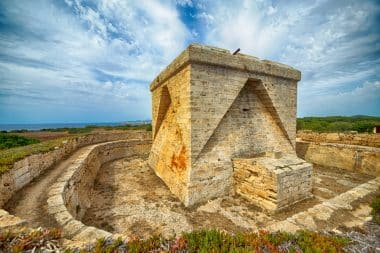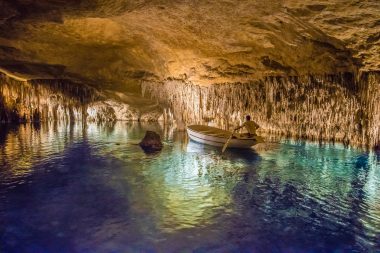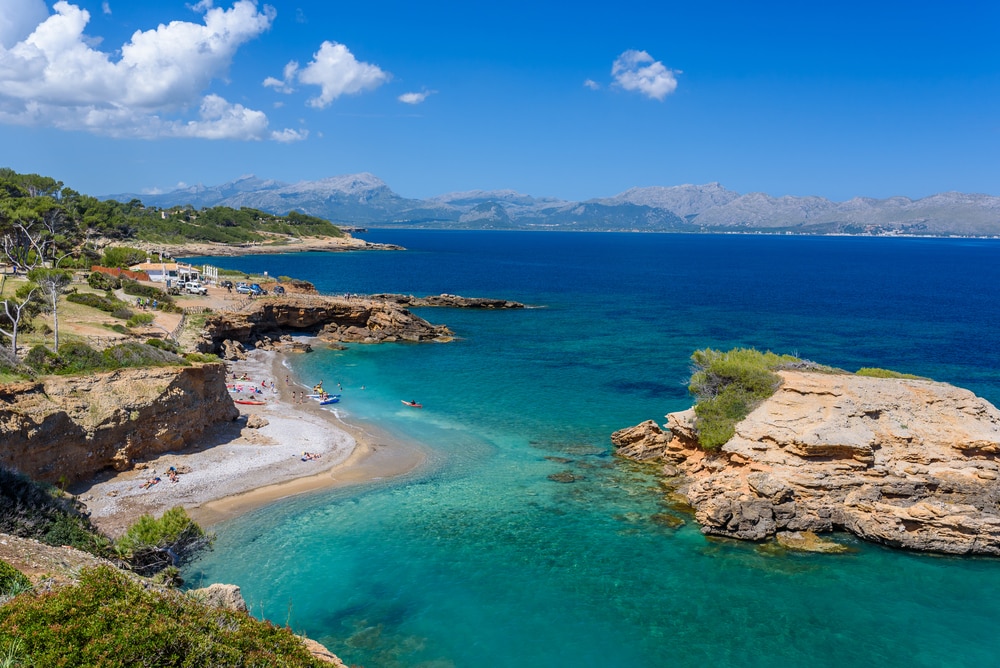The town of S’Illot on the east coast of Mallorca is remembered for its geographical location. The village of 2000 inhabitants is divided by the torrent “Torrent de Ca n’Amer”. Where it reaches the sea, a handsome bridge spans over it, which was only renewed in 2019. S’Illot is an urbanization that was built from 1959 especially for tourists. It is located exactly between the larger tourist magnets Cala Millor in the north and Porto Christo in the south. And always seems to be a bit in their shadow.
Hotels and apartments dominate the townscape today. In order to remain competitive, a lot has been invested in hotel renovations in recent years. The big plus of the town is the sandy beach Cala Moreia near the hotel – about 350 meters long and 50 meters wide. A little further south is Cala Morlanda with its sandy and rocky beach, which is often visited by divers. It is only 60 kilometres from S’Illot to Palma de Mallorca Airport and only 16 kilometres to the city of Manacor, which is well worth seeing, and has become famous for the “Pearls of Mallorca”.
S’Illot hit the headlines in the winter of 2018 due to an accident: the Ca n’Amer torrent became a flash flood, damaging the bridge and washing cars and rubbish into the sea. At that time, ten people were killed. The damage has since been repaired, and the reconstruction has upgraded S’Illot.
Excavation site of the “tower culture” at the entrance to the village
Holidaymakers who arrive in S’Illot via the Ma-2021 road are at the destination of a journey through time: they are the first to land… in the Bronze Age. Right at the entrance to the town, on Carrer Rosa del Vents, is the archaeological site “Talayotic Settlement of S’Illot” (Poblat talaiòtic de S’Illot). Visitors can walk over footbridges and bridges with display boards and learn that people of the so-called Talayotic culture lived in the tourist resort 3000 years ago. There are only ruins on the site, but you can learn how our ancestors built impressive dwellings, two-storey towers and village enclosures made of thick stones. The neighboring museum brings you this culture of the Balearic Islands even closer. In Sa Coma, which adjoins S’Illot to the north and is within walking distance, there is also an excavation site.
Watch lions, monkeys and giraffes in the car in the safari park

If you’ve had enough of beach life under the umbrella in S’Illot, you can visit the safari park at Sa Coma to see wild animals. With a rental car or their own car, visitors drive through the 40-hectare “steppe” and observe giraffes, monkeys and lions – almost like in the wild. There are no cramped cages here, as unfortunately still in some zoos .
A great destination is also the protected peninsula of Punta n’Amer with deciduous forest north of Sa Coma, which holidaymakers can reach by rental bike or on foot. There are beautiful hiking trails, an observation tower with a museum and a restaurant with a great view. To the left, above Cala Millor, holidaymakers can see the beautiful country town of Son Servera and to the right to Cap d’es Pinar at the end of the Costa dels Pins. If the beach in S’Illot is too narrow for you, you can switch to the wider one in Sa Coma – where, according to tourists, “there is usually a little more going on”. A beach promenade connects the two tourist resorts. There, holidaymakers will find restaurants, boutiques, beach shops, souvenir shops and grocery stores.
Excursion to the Dragon’s Cave in Porto Cristo

A special excursion leads to a visit to the “Dragon’s Cave” (Coves del Drac) in neighboring Porto Cristo. This is a spectacular 1700-meter-long cave system with an underground lake where visitors take a small boat ride. More impressive, however, are the huge, well-lit stalactites and stalagmites. Some look like columns, but others look like artistically created sculptures. The highlight of the cave visit is a concert. Music is played on a boat in the lake, which glides picturesquely past the spectators. By the way, every Sunday from 9 a.m. to 2 p.m. there is a weekly market in Porto Christo – with fruit and vegetables, handicrafts, textiles and accessories. The market is located directly on the sea at the entrance to the marina


